 |
|

|
 |
TABLE of CONTENTS
|
State hosts first rail conference, webinar |
By Mary McFarland Brooks
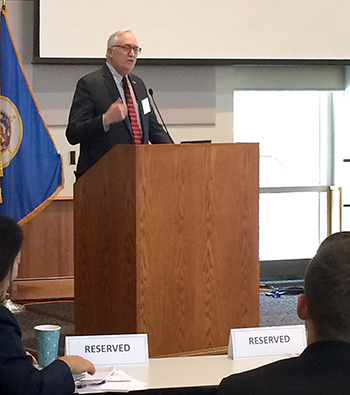
Bill Gardner, Office of Freight and Commercial Vehicle Operations director, spoke about the state of the freight and rail industry at the rail conference Dec. 5. Photo by Sue Roe |
MnDOT held Minnesota's first statewide rail conference and webinar Dec. 5. The conference brought together all levels of government leaders, rail industry and academia to share information and discuss Minnesota's growing rail future.
The conference showcased several panels on a variety of rail topics and trends. Commissioner Charlie Zelle kicked off the conference, welcoming participants to what he said he hoped would be the first of many MnDOT rail conferences.
“Today is an opportune time, with the change in administrations, for the industry, government and other stakeholders to assess where we stand with the respect to the rail system in Minnesota, and to reaffirm rail priorities,” he said.
Gerard McCullough, professor from the University of Minnesota’s Department of Applied Economics, led the first panel that included Bill Gardner, MnDOT’s freight director, addressing the state of the freight rail industry.
“Minnesota has more than 4,500 miles of freight rail and the network carries 25 percent of all freight movement in the state and is expected to grow by 25-40 percent by 2040; it is critical that we improve communications and coordination between state and local agencies and the rail industry for the future of rail in Minnesota,” said Gardner.
Peter Dahlberg, MnDOT rail planner and program manager, participated in the rail safety panel.
“We continue to make improvements in rail grade crossing safety, including roadway grade separations where needed, and supporting the implementation of new safety technologies, like Positive Train Control,” said Dahlberg.
Kevin McKinnon, deputy commissioner of Minnesota Department of Employment and Economic Development, led the final panel on opportunities for growth along rail corridors.
“Passenger rail planning has also made significant progress in services that enhance mobility and connect Minnesotans to the Midwest Passenger rail system as envisioned in the state rail plan," said Dan Krom, MnDOT passenger rail director and webinar liaison at the conference.
Keynote speaker, Andrea Green Armstrong, Federal Railroad Administration’s Midwest project manager, talked about the growth in passenger rail nationwide and potential passenger rail projects in Minnesota, including:
- Second train to Chicago (Twin Cities, Milwaukee, Chicago)
- Northern Lights Express (high-speed rail between Twin Cities and Duluth)
- Northstar commuter rail extension to St. Cloud
Tenzin Dolkar, rail director for the state of Minnesota, provided closing remarks for the conference and webinar. More information about the conference is available at: www.mndot.gov/rail-conference.
After the conference concluded, Zelle led the final meeting of the Governor’s Rail Council, an interagency group created by Executive Order that is working to improve communication between state agencies and the rail industry. The focus of this group is on safety measures and emergency preparedness training; exploring economic development opportunities with local governments, and enhanced community engagement throughout the state. |
 |
|

|
 |
TABLE of CONTENTS
 |
River shipping season ends on Upper Mississippi River |
By Jesse Johnson, Office of Freight and Commercial Vehicle Operations
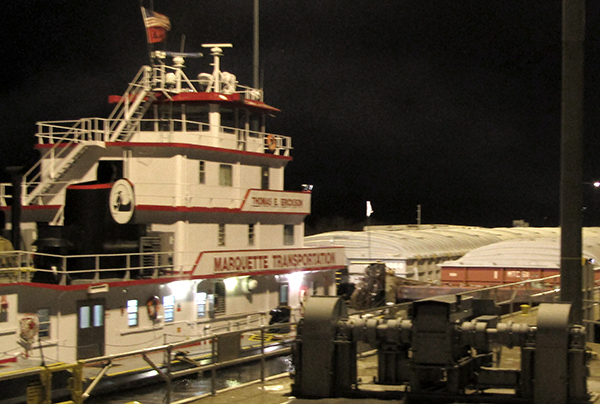
The departure of the Motor Vessel Thomas E. Erickson on Nov. 25 marked the end of the shipping season on the Upper Mississippi River. The 11-barge tow was bound for St Louis, loaded with corn, soy beans, rubber and scrap metal. MnDOT supports commercial waterway navigation through the Port Development Assistance Program, which provides capital investment funding assistance through grants to public ports in the state. The Port Development Assistance Program is used to upgrade facilities and infrastructure, as well as rehabilitate and expand port capacity, with the goal of improving access to waterway transportation for Minnesota industries and the public. Photo by Pam Niebur, U.S. Army Corps of Engineers |
|
 |
|

|
 |
TABLE of CONTENTS
 |
Smith Avenue High Bridge reopens after 15-month renovation |
|
By Nick Carpenter, Metro District communications and engagement
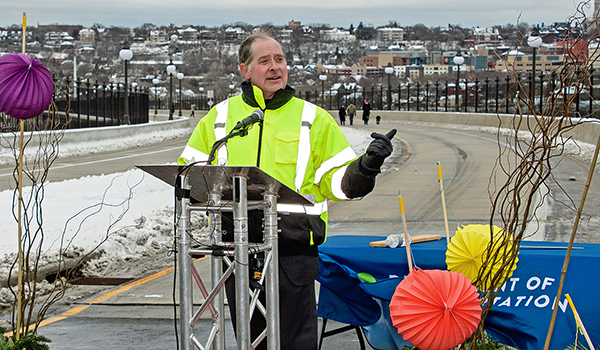
Commissioner Charlie Zelle joined local legislators, community partners and more than 100 community members Sunday, Dec. 2, to celebrate the grand opening of the Smith Avenue High Bridge in St. Paul. The event featured a brief ribbon cutting followed by a short, festive winter walk to a local business to celebrate. The bridge had been closed since September 2017 while crews reconstructed the deck and improved pedestrian and bicycle accommodations on the bridge. Photo by David Gonzalez |
|
 |
|

|
 |
TABLE of CONTENTS
 |
Title II Response Team investigates ADA complaints |
By Marilyn Jordahl Larson, Operations Division
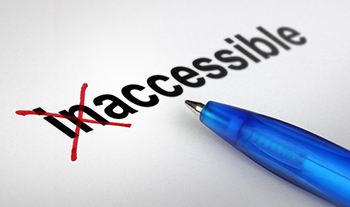
|
The Americans with Disabilities Act and Rehabilitation Act guarantee equal access to MnDOT services, programs and activities for persons with disabilities. The ADA prohibits MnDOT from discriminating on the basis of disability and requires MnDOT to have a grievance procedure that members of the public can use to make a disability related complaint.
In October 2017, the Operations Division assumed Title II responsibility and formed a Title II Response Team consisting of Amr Jabr, ADA title coordinator; Marilyn Jordahl Larson, Operations Division; Kristie Billiar, ADA program policy manager; Ben Lowndes, Liaison Services; and Lindsey Hanson, Office of Chief Counsel. The Title II Response Team was formed to formalize and implement MnDOT’s Grievance Procedure, educate staff on their role, and when necessary, to conduct investigations and offer options to resolve disability-related complaints. If the complainant disagrees with the decision, they have the option to appeal to the assistant commissioner of the Operations Division.
“The ADA Title II grievance procedure provides the public a structured way to have concerns about the accessibility of MnDOT’s services, programs and activities addressed in a timely manner; it’s good customer service,” said Jody Martinson, assistant commissioner of the Operations Division.
The Title II Response Team has conducted agency-wide outreach with MnDOT staff who have interactions with the public. The focus of the outreach was to educate staff on how to recognize a disability-related complaint. This includes always offering a copy of the Grievance Procedure and informing the Title II Response Team of the complaint (Accessibility.DOT@state.mn.us ), whether the complaint was resolved, or if further assistance is needed. This information is needed to fulfill MnDOT’s annual reporting requirements.
“From a signal operations standpoint, the most important thing to remember is to send your complaint information to the Title II Response Team when the issue has been addressed, or if assistance is needed to resolve the complaint,” said Michael Fairbanks, Metro District Traffic Signal Operations.
“Whenever possible, MnDOT staff are encouraged to resolve an issue as quickly as possible,” said Kristie Billiar, ADA policy program manager. “The ADA complaint process should not be a barrier to resolving issues that MnDOT staff would otherwise quickly address, such as Automated Pedestrian Signal repair or snow removal, but to ensure that we are tracking our response on all ADA-related needs. The complaint process also provides the necessary support to solve more complex issues, like reasonable accommodation requests.”
Since the Operations Division assumed Title II responsibility, it has received 18 Title II complaints, 16 are resolved, with two cases still active. The complaints cover a wide range of topics, from modifications to policy, procedure or rule, to removal of physical barriers such as rest area accessibility, signal improvement, bariatric accommodations and sidewalk additions.
For questions about the ADA complaint process, email Accessibility.DOT@state.mn.us or call 1-833-400-8432. An “A-Z” iHUB website for internal Title II resources is currently in development and will be live by the end of December. |
 |
|

|
|

|
 |
TABLE of CONTENTS
 |
On the job: David Cathcart monitors the highways for icy spots, debris |
By Sue Roe
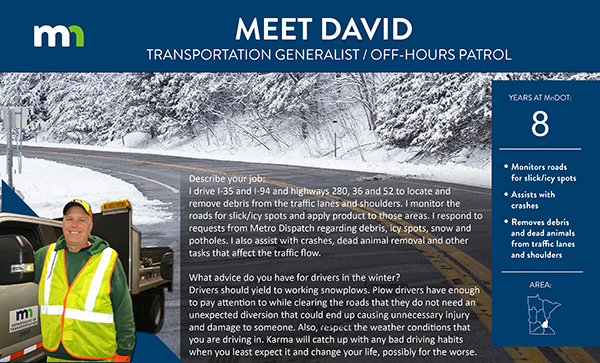
Do you or a co-worker have an interesting job to share with readers? Send us your ideas, and we’ll contact you for more information.
Recent employee profiles:
|
|
 |
|
| |
|



